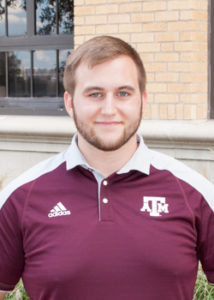Center for Nuclear Security Science and Policy Initiatives (NSSPI) graduate students Jeremy King and Jackson Wagner have been selected to participate in the U.S. Department of Defense (DoD) SMART Scholarship-for-Service Program. The SMART Scholars Program sponsors students to pursue studies in science, technology, engineering, and math (STEM) fields currently considered in high demand by the U.S. government as part of a concentrated effort to enhance the workforce of the DoD. The SMART program assigns scholars to a Department of Defense facility for summer internships and provides employment after completion of the degree. Both King and Wagner are Ph.D. students working with NSSPI Deputy Director Dr. Craig Marianno, and they will both work for the DoD in Virginia upon graduation.

King’s dissertation project is an integrated circuit beta particle detector intended for field use. The Radiation Integrated Circuit (RIC) was developed at Texas A&M to detect alpha particles, beta particles, and neutrons in different configurations. The detector uses radiation-soft and radiation-hard areas to exploit the anomalies created in radiation-soft circuits when they are struck by charged particles. The project began with MCNP simulations to update estimates of the detector’s performance and will carry on to include alpha and beta particle experiments. . He previously worked on a polyvinyl toluene (PVT) detector feedback package. King earned a B.S. in Mechanical Engineering from the University of Texas at Austin in 2017.

Wagner’s main interests are in radiation detection for nuclear security and nonproliferation applications. Wagner’s current research focuses on developing a method to predict the ambient neutron count rate in detection systems commonly used in nuclear security scenarios. Using these detectors to determine the presence of an illicit source requires the knowledge of the detectors’ ambient responses, which is relatively simple for gamma rays, but it is more difficult for neutrons. A method to estimate the ambient neutron response applies an observed correlation between the neutron detector response and the gamma detector’s high energy response in many scenarios. The improved knowledge of the ambient neutron detector response that this method would provide will make it easier for these systems to locate neutron sources (which is generally indicative of special nuclear materials). Wagner received a B.S. degree in Nuclear Engineering and Radiological Sciences from the University of Michigan – Ann Arbor in 2016.